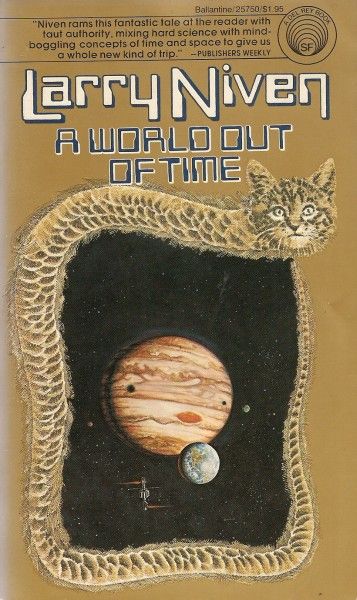About Strange People in the Strangest Place
A World Out of Time
By Larry Niven

1 Oct, 2017
ISFDB lists 1976’s A World Out of Time as one of Larry Niven’s State novels1, which it is. I liked to think of it as the last fun Niven novel. Having reread it, I am not so sure that’s right.
Jerome Branch Corbell had himself frozen in 1970 in a desperate bid to escape terminal cancer. In 2190, a man with Corbell’s memories woke up to discover a world unlike any Corbell had expected back in 1970, a world that expected him to expiate a crime he had no memory of committing … with a mission that would consume three centuries.
Corbell’s new body once belonged to a criminal whose crime was so heinous that the State wiped his mind. Corbell’s memories were retrieved from his frost-damaged body, a process that reduced the original Corbell to a slurry. It is hoped that he will make a better starship pilot than the criminal. If not, Corbell’s brief reincarnation will end with a mindwipe and the selection of another unwilling donor.
Corbell plays along until the State launches him into deepest space to seed the worlds of nearby stars with terraforming packages. As soon as he is out of State control, Corbell commandeers his Bussard Ramjet and heads towards the galactic core. After all, a simple calculation proves if the ramjet can maintain a one-gee acceleration indefinitely, the ramjet can reach the core in just twenty-one years (in the ship’s frame of reference, that is).
Two factors complicate his plans. The first is that his ship is possessed by the beamed mind of Peerssa, an irate State bureaucrat. The second is that the starship isn’t able to maintain that one gee acceleration indefinitely. It takes centuries for Corbell to get to the core; even with cold sleep, he is an old, dying man when he arrives.
The giant black hole at the core of the Milky Way offers the chance to return home to Earth before death claims him. The trip is only swift in Corbell’s frame of reference. By the Earth’s clocks, three million years have passed.
The Solar System is unrecognizable. Marooned on a transformed Earth, encountering only ageless, malevolent Children and a conniving crone named Mirelly-Lyra, Corbell searches for freedom, answers, and the slim hope of immortality.
~oOo~
It would be nice to blame Niven’s descent from Known Space, a generally pleasant setting, to the Boot of the State Stamping on the Face of Humanity for Thousands of Years, on Jerry Pournelle’s influence. However, I think this is a matter of convergence, not influence. The State first appeared in 1971’s Rammer, before JEP and Niven began collaborating. Of course, perhaps it was JEP who handed Niven a copy of Wittfogel’s Oriental Despotism.
As is the case for too many SF novels, the worldbuilding here does not bear close examination. If the ship’s computer is powerful enough it can run an emulation of a human mind, why bother with a living pilot? If everyone knows 1970s era cryogenics damaged cells beyond revival, why did a world that went through two major wars and a complete social transformation bother to preserve the corpsicles?
Some of the classic Niven touches are present. A good part of the novel involves exploring a hothouse Earth that has been moved from its present location to an orbit around Jupiter, a move forced by the artificial transformation of the Sun into a red giant. Corbell does eventually find out who was responsible for the changes and why they seemed like good ideas at the time.
Alas, the novel isn’t all E. E. (Doc) Smith-ish planetary engineering and playing with deep time. What really drives the plot is some skeevy gender politics. Granted, as Jo Walton observed about A Gift From Earth, Niven’s gender politics were always dubious. But A World Out of Time goes well beyond Gift’s lack of imagination.
Niven’s central assumption is that men and women are by nature hostile, tied together only by men’s desire to have sex with women, and women’s desire to trade sex for status and wealth. The terrifying crone Mirelly-Lyra is quite explicit on this point; aside from her desire to live, the reason she so avidly pursues immortality is because she wants her sexual weapons restored to her.
Removing sex thanks to an immortality treatment that halts aging before puberty only makes things worse. Without the endless bargaining over access to sex, men and women form naturally hostile camps; Boys befriend Boys but Boys and Girls never find common ground2. At best, a world filled with ageless Children is one where Boys and Girls maintain an endless cold war. In practice, it’s one where the Earth itself may well be doomed.
I’m very much afraid that the suck fairy waved her wand over this book in the intervening years. Or my tolerance for misogyny has waned. Or both. Two thumbs down.
A World Out of Time is available here (Amazon) and here (Chapters-Indigo).
1: The ISFDB also merges Niven’s Leshy Circuit stories with the State setting, for no good reason that I can see. The Leshy Circuit (which includes “The Fourth Profession,” inexplicably left out of the sequence by ISFDB) explicitly includes aliens as a significant part of the setting. The State stories do not. As well, none of the Leshy stories include an omnipresent, autocratic State.
2: There’s not much evidence women are able to form friendships even with each other, although part of that may be that there aren’t a lot of women in this book and that one of them is the grasping Mirelly-Lyra, who sees other people purely in terms of what they can do for her.
